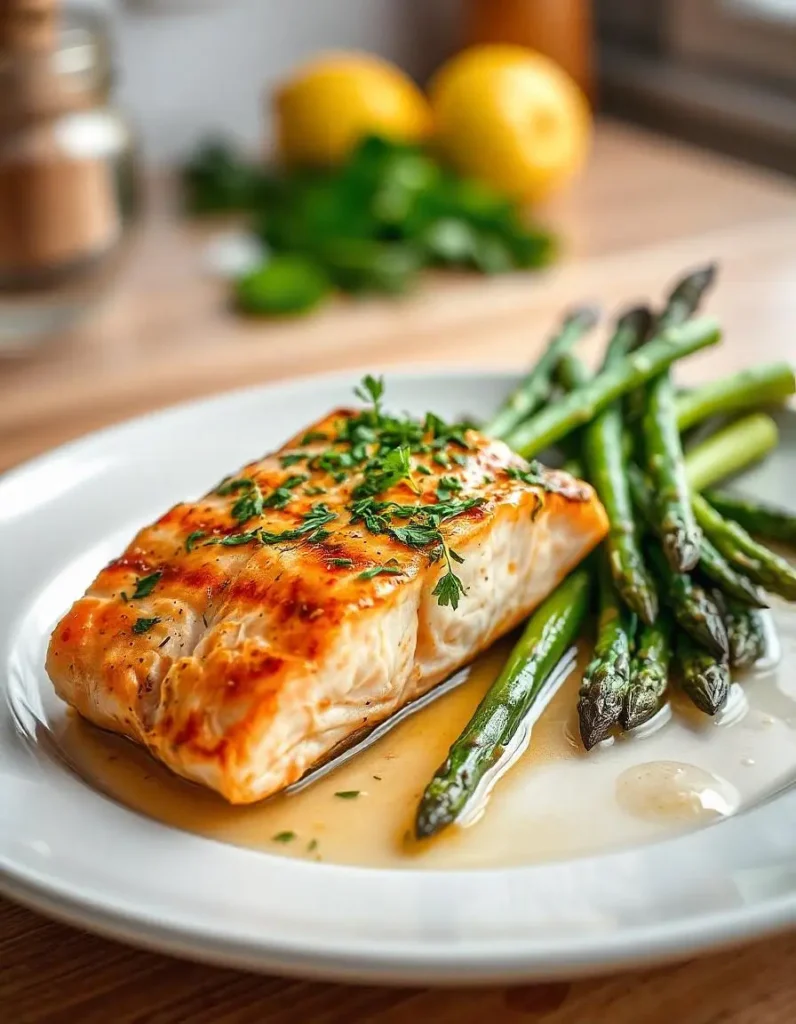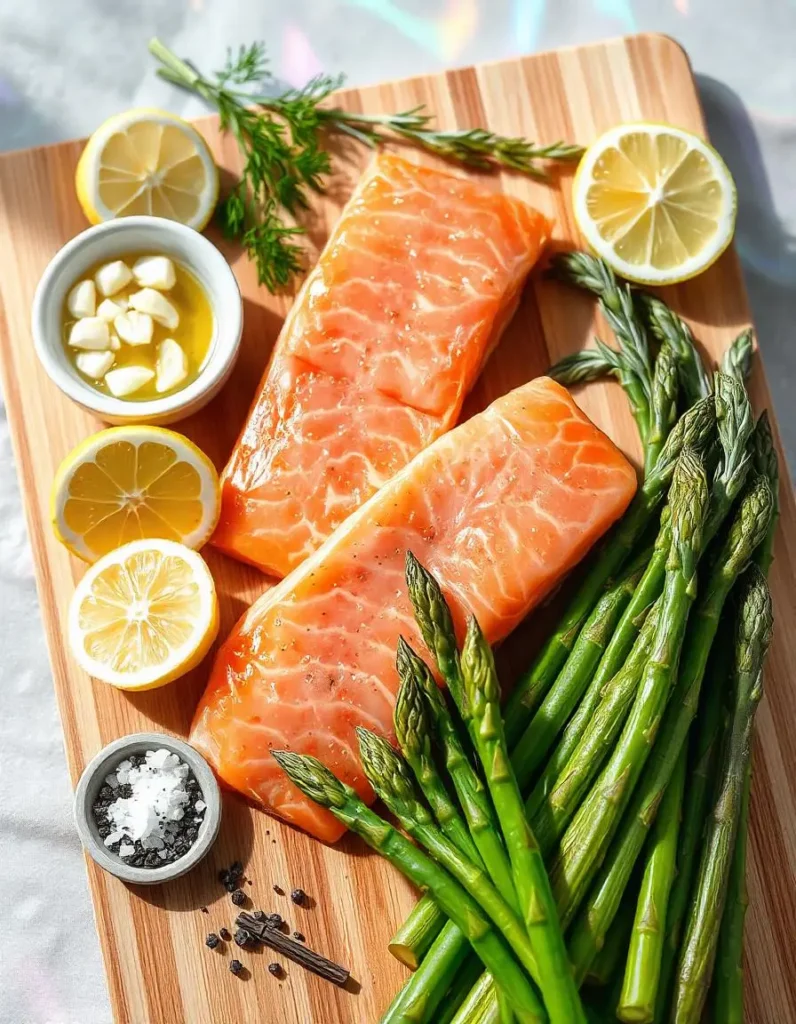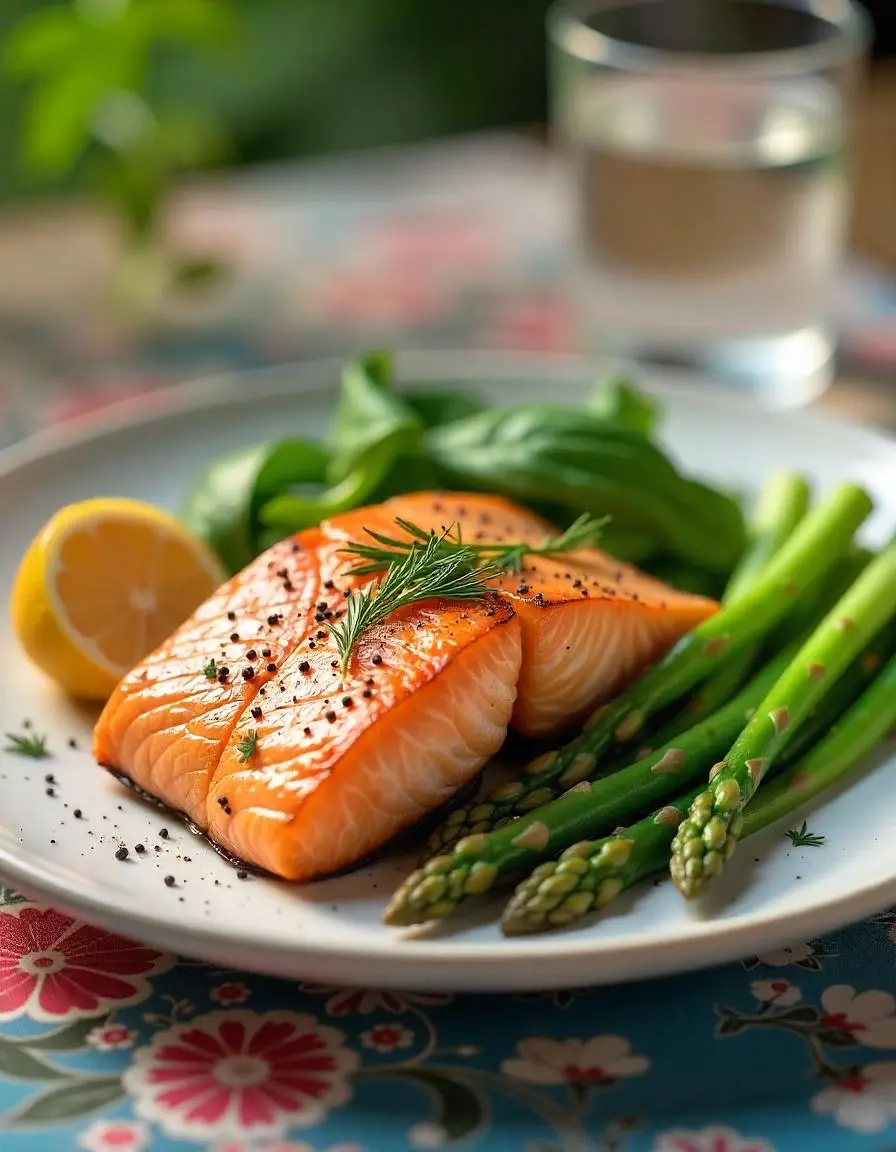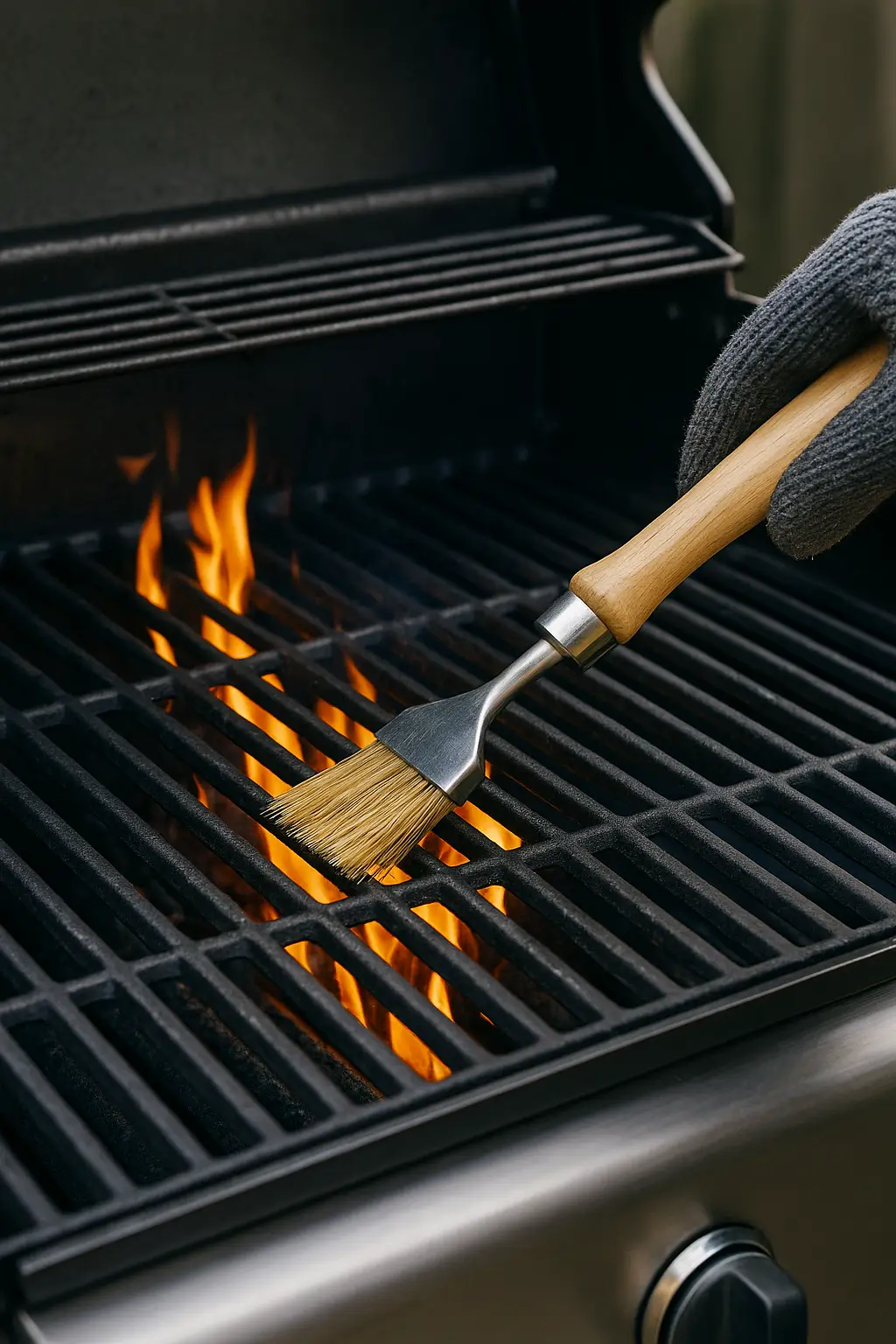A Healthy Recipe
Grilled salmon with asparagus is more than just a delicious meal, it is a healthy grilled meal that fits perfectly into a healthy lifestyle. This dish combines tender, smoky salmon fillets with crisp grilled asparagus for a low-carb dinner that is both satisfying and nourishing. In this article, we will explore why this grilled salmon recipe is ideal for those seeking healthy dinner ideas, provide a step-by-step recipe, and share tips, variations, and interesting facts.

Why This Grilled Salmon Is Great for Diet?
Both salmon and asparagus provide a nutritious, balanced meal with low carbs. Salmon is loaded with omega-3 fatty acids-healthy fats that support heart health. It is particularly important for individuals with diabetes, who often face a higher risk of heart disease. Meanwhile, asparagus is a low-calorie vegetable rich in fiber, vitamins, and minerals. Together, they make a satisfying, nutrient-packed meal.
Choosing the right foods is crucial for managing blood sugar and health, and this grilled salmon with asparagus offers a perfect balance for a diet. Here are several reasons why this dish makes a smart choice :
- Low in Carbohydrates: Salmon contains zero carbohydrates, and asparagus is a non-starchy vegetable very low in carbs. This means the meal has minimal impact on blood glucose levels. One cup of asparagus has under 5 grams of carbs (with about 3 grams of fiber), making it an ideal side for controlling post-meal blood sugar spikes. By enjoying a generous portion of asparagus with protein-rich salmon, you can have a filling dinner while keeping total carbs low.
- High in Lean Protein: Each serving of salmon provides an excellent amount of high-quality protein. Protein is essential for muscle maintenance and helps slow the digestion of meals, which can lead to more stable blood sugar levels after eating. A grilled salmon fillet (typically 4–6 ounces) supplies roughly 25–35 grams of protein, helping you feel full and satisfied without the need for carb-heavy foods.
- Rich in Healthy Fats (Omega-3s): Based on data from healthline.com, Salmon is famous for its omega-3 fatty acids, particularly EPA and DHA, which are heart-healthy fats. For individuals with diabetes, heart health is especially important, as diabetes increases the risk of cardiovascular disease. The omega-3s in salmon can help reduce inflammation and improve cholesterol levels (by raising “good” HDL cholesterol), supporting overall heart health. Unlike unhealthy saturated fats, the fats in salmon are beneficial and can contribute to better insulin sensitivity and reduced risk of complications.
- Packed with Nutrients: Both main ingredients are nutrient-dense. Salmon delivers B vitamins (like B12 and B6), vitamin D, selenium, and potassium, which support energy metabolism, immunity, and nerve function. Asparagus contributes folate, vitamin K, vitamin C, and antioxidants. Notably, asparagus is a source of chromium a trace mineral that may enhance insulin’s ability to transport glucose into cells. These nutrients work together to support metabolic health, making the meal not just low in carbs but high in vitamins and minerals.
- No Added Sugars or Refined Starches: This recipe uses simple seasonings (like herbs, lemon, and olive oil) and avoids any sugary marinades or breaded coatings. Grilling the salmon and asparagus with heart-healthy olive oil keeps the dish naturally healthy and low-carb, unlike recipes that use sweet sauces or high-carb sides.
- By combining lean protein, healthy fats, and low-glycemic vegetables, this grilled salmon with asparagus aligns with dietary recommendations for diabetes. In fact, the American Diabetes Association (ADA) encourages including fish in your diet at least twice a week, especially fatty fish like salmon, as part of a balanced diabetes meal plan. Likewise, non-starchy vegetables such as asparagus are staples of a diet plate. This dish meets those guidelines, offering a wholesome option that can help with blood sugar management and overall health.
Ingredients needed for Making the recipe:
For this Grilled Salmon with Asparagus recipe we need :
| Ingredients | Quantity |
|---|---|
| Salmon fillets | 4 (about 6 oz each) |
| Asparagus spears | 1 pound |
| Olive oil | 2 tablespoons |
| Lemon | 1 (for juice and zest) |
| Garlic cloves, minced | 2 |
| Salt | 1/2 teaspoon |
| Black pepper | 1/2 teaspoon |
| Fresh herbs (like dill or parsley, optional) | 1 tablespoon, chopped |

Yield: 4 servings.
Prep Time: 10 minutes (marinating/seasoning time, can be done while grill preheats).
Cook Time: 10–12 minutes.
Total Time: ~22 minutes.
Time needed: 22 minutes
- Preheat the Grill:
Preheat your gas or charcoal grill to medium-high heat (approximately 400°F). If using an indoor grill pan, heat it over medium-high. Clean the grates well and lightly oil them (using a brush or paper towel with cooking oil) to minimize sticking.

- Season the Salmon:
Pat the salmon fillets dry with a paper towel. In a small bowl, combine 1 tablespoon of olive oil, the minced garlic, lemon juice, dill, and paprika. Brush this mixture evenly over each salmon fillet. Season the fillets with a sprinkle of salt and black pepper on both sides. If time allows, let the salmon marinate in this rub for about 10–15 minutes at room temperature to enhance flavor (while you prepare the asparagus).
- Prepare the Asparagus:
In a bowl, toss the asparagus spears with the remaining 1 tablespoon of olive oil. Season with a pinch of salt and black pepper. Ensure each spear is lightly coated in oil, which will help them grill evenly and prevent drying out.
- Grill the Salmon
Place the salmon fillets on the preheated grill, skin-side down first (if skin-on). Close the lid (for outdoor grill) and cook for about 4–5 minutes. The skin side will crisp up and the salmon will begin to cook through. Carefully flip the fillets using a wide spatula. Cook for another 3–5 minutes on the second side, until the salmon is just cooked through. The exact timing will depend on thickness – a general rule is to grill until the flesh is opaque and flakes easily with a fork. For best results, cook salmon to an internal temperature of 145°F at the thickest part (USDA safe temperature for fish). Avoid overcooking, as salmon can become dry; it’s okay if the center is slightly translucent when you take it off the grill, as it will continue to cook for a minute from residual heat.
- Grill the Asparagus:
While the salmon is grilling, place the asparagus spears on the grill grates perpendicular to the bars (or use a grill basket or foil placed on the grill to prevent them from falling through). Grill the asparagus for about 5–7 minutes, turning them occasionally with tongs. They are done when they have char marks, are bright green, and tender-crisp (softened but still slightly firm). Thinner asparagus will cook faster, while very thick spears might need an extra minute or two. Be mindful not to burn them; they should retain some crunch.
- Serve:
Remove the salmon and asparagus from the grill. Let the salmon rest on a plate for 2 minutes to allow the juices to redistribute (this helps keep the fish moist). Squeeze additional fresh lemon juice over the salmon and asparagus for a burst of flavor. Plate each salmon fillet with a portion of grilled asparagus. Garnish with lemon wedges and fresh parsley or dill sprigs if desired. Enjoy your meal while it’s warm.
Cooking Note: If you do not have an outdoor grill, you can achieve similar results using an oven broiler or stovetop grill pan. To broil, place seasoned salmon and asparagus on a foil-lined baking sheet and broil on high for about 8–10 minutes, flipping the asparagus once and the salmon if needed, until done. For a grill pan, cook over medium-high heat following the same timing as above. Always ensure proper ventilation when high-heat cooking indoors.
This grilled salmon with asparagus is ready in under 30 minutes and brings restaurant-quality flavor to your table. It’s a healthy grilled meal that requires minimal ingredients and delivers maximum nutrition – perfect for anyone looking for a low-carb dinner that doesn’t compromise on taste.
Tips for Perfectly Grilling Salmon and Asparagus
Grilling fish and vegetables might seem intimidating to some, but with a few simple tips you can achieve perfect results every time. Here are some expert tips to ensure your grilled salmon and asparagus turn out flawless:
- Choose Quality Ingredients: Start with the freshest ingredients you can find. Opt for salmon fillets that are bright in color (reddish-orange for wild salmon) and have a mild, briny smell (fresh fish should not smell overly “fishy”). Wild-caught salmon is often considered higher in omega-3s and has a richer flavor, while farmed salmon can be more readily available and still nutritious – either works for this recipe. For asparagus, select firm, bright green spears with closed tips. Thicker spears hold up well on the grill, but even thin ones can work if you handle them gently.
- Preheat and Oil the Grill: Always preheat your grill to the proper temperature (medium-high for this recipe) before cooking. A well-heated grill will sear the salmon nicely, preventing it from sticking too much and giving it those appealing grill marks. Additionally, oil the grill grates or use a high-heat non-stick cooking spray right before placing the food on the grill. This extra step ensures the salmon skin doesn’t tear and the asparagus doesn’t stick, making flipping and removal much easier.
- Pat Dry and Season Well: Moisture is the enemy of a good sear. Pat the salmon fillets dry to remove excess moisture, which helps them brown instead of steam. Do the same if your asparagus is wet from rinsing (dry it with a clean towel before tossing in oil). Season generously but smartly , a bit of salt, pepper, and herbs can go a long way in amplifying flavor. Since this is a diabetes-friendly recipe, we avoid sugary marinades; however, you can still add depth by using spices (like paprika, garlic, or even a salt-free lemon-pepper blend). If using a marinade or rub with acidic ingredients like lemon juice, keep the marinating time under 30 minutes so the acid doesn’t “cook” the fish or make it mushy.
- Monitor Cooking Time and Temperature: Salmon fillets cook quickly, typically 8–12 minutes total on the grill depending on thickness. Overcooking is a common mistake , it can dry out the fish. Keep an eye on the color and texture: when the flesh turns opaque pink and flakes easily under gentle pressure, it’s done. If you have a food thermometer, check for about 140–145°F in the thickest part. The fish will continue to cook slightly after coming off the grill (carryover heat), so you can even remove it at 140°F for a moister result. Asparagus also cooks fast; grill them until bright green with light char, but still somewhat firm so they retain a pleasant snap. Thin asparagus may only need 4–5 minutes.
- Use Proper Grill Tools: Use a wide, flat spatula (often called a fish spatula) to turn and remove the salmon – this helps support the fillet and prevents it from breaking apart. For asparagus, tongs are ideal for rolling the spears to get even grill marks on all sides. If you have a grill basket or a piece of foil, you can use it for the asparagus to simplify handling, especially if the spears are very skinny.
- Let It Rest: Just as you would with grilled steak or chicken, allow the grilled salmon to rest briefly after cooking. A rest of 2–3 minutes lets the juices redistribute throughout the flesh, yielding a more tender, moist bite. Asparagus doesn’t need rest and can be served immediately, but letting the salmon rest while you plate the asparagus is a good sequence.
- Brighten Before Serving: Finish your grilled salmon and asparagus with fresh elements to enhance flavor without added salt or carbs. A squeeze of lemon on the hot-off-the-grill salmon imparts a zesty freshness and helps cut through the richness of the fish. Fresh herbs like dill, parsley, or basil sprinkled on top can also add aroma and color. These little finishing touches make the dish feel gourmet and inviting.
By following these tips, your grilled salmon and asparagus will come out perfectly cooked – tender salmon with a slight char on the outside and moist flakiness inside, plus asparagus that is smoky and crisp-tender. Grilling is all about technique and attention; with practice, you’ll be able to grill this healthy meal with confidence every time.
Recipe Variations and Healthy Substitutions
One of the great things about this grilled salmon with asparagus recipe is its versatility. You can modify ingredients and flavors to suit your taste or dietary needs while keeping it diabetes-friendly. Here are some variations and healthy substitutions to consider:
- Alternate Seasonings and Marinades: While this recipe uses a lemon-garlic herb rub, you can change the flavor profile easily. For a spicy kick, try a Cajun seasoning or a pinch of cayenne pepper on the salmon. If you prefer an Asian-inspired taste, marinate the salmon in a mixture of soy sauce (or tamari for gluten-free), ginger, and a touch of garlic – just be sure to choose a low-sodium soy sauce and avoid adding sugar to keep it diabetic-friendly. Another idea is brushing a bit of heart-healthy Dijon mustard on the salmon along with herbs for a tangy crust. These variations keep the dish exciting without compromising its status as a healthy grilled meal.
- Different Vegetables: Not a fan of asparagus or want to include more variety? You can substitute or add other low-carb veggies to grill alongside the salmon. Some excellent options include zucchini or yellow summer squash (cut into lengthwise slices), bell peppers (cut into large flat pieces), eggplant rounds, broccoli florets (tossed in a bit of oil and perhaps grilled on a veggie tray or basket), or even Brussels sprouts (par-boil them first for a few minutes, then skewer or place in a grill basket to finish on the grill). All of these are non-starchy vegetables that are relatively low in carbohydrates and fit well into a diabetic meal plan. By mixing and matching vegetables, you’ll expand your repertoire of asparagus recipes and other veggie dishes while keeping meals interesting.
- Using Other Proteins: Salmon is the star for its omega-3 benefits, but if you want to change things up, you can use this recipe template with other proteins. For example, other fatty fish like mackerel, trout, or Arctic char can be grilled in a similar way and are also omega-3 rich foods. If you prefer a milder fish, try halibut or cod, but be aware these are leaner and can dry out faster on the grill (adjust cooking times accordingly). For those who do not eat fish, skinless chicken breast or thighs can be marinated and grilled (you’ll get a lean protein, though not the same healthy fats as salmon). Even firm tofu steaks can be grilled with a similar marinade as a vegetarian option. Keep in mind that if you substitute the protein, the nutrition will change (for instance, chicken and tofu lack omega-3s but are still low-carb proteins). Always avoid breading or high-sugar sauces to maintain a diabetes-friendly recipe profile.
- Cooking Method Variations: Grilling imparts a distinct smoky flavor, but you can cook the salmon and asparagus using other healthy methods if needed. Baking or roasting is an easy alternative – you can place the salmon and asparagus on a sheet pan in a 400°F oven (or use the broiler) and cook for a similar duration, as mentioned earlier. Pan-searing the salmon on the stovetop and then quickly sautéing or oven-roasting the asparagus is another option. These methods still use minimal added fat and no carbs, so they remain great for a diabetic diet. If using an alternate method, stick to the same seasonings and the dish will have a slightly different but still delicious character.
- Healthy Substitutions: To reduce sodium, use herbs, spices, and acids (lemon/vinegar) for flavor instead of extra salt. To reduce fat, you can use a cooking spray for the asparagus instead of the full tablespoon of oil (though the olive oil is a healthy fat, some may want to cut calories). If you require an even lower-fat dish, you might choose a very lean fish (like cod) or cut down the olive oil marinade on the salmon. However, keep in mind that the fats in salmon and olive oil are heart-healthy and satiating, especially important in a low-carb meal to keep you full.
- Adding a Smart Carb (if needed): This recipe on its own is extremely low-carb. If you have room in your meal plan for some carbohydrates or are feeding others without carb restrictions, you can add a small portion of a healthy whole grain or starch on the side. For example, a half-cup of quinoa, a small sweet potato, or a side of black beans could complement the meal and still keep it balanced for someone with diabetes. Be sure to adjust portion sizes to keep the total carbs within your target range. Including a high-fiber grain can be a nice way to round out the meal for those who want it, but the dish is fully satisfying even without these additions.
By exploring these variations, you can enjoy the core concept of grilled salmon and vegetables in many forms. Whether you change the seasoning, swap the veggies, or try a new cooking method, you’ll still be preparing healthy grilled meals that align with the goals of a diabetes-friendly diet. Flexibility in cooking is key to maintaining long-term healthy eating habits, and this recipe is a great foundation to build upon.
Frequently Asked Questions (FAQs)
A: Absolutely. Grilled salmon is not only safe for people with diabetes, it’s often encouraged as a nutritious meal choice. Salmon contains no carbohydrates, so it will not directly raise blood sugar. Instead, it provides protein and healthy fats that can help stabilize blood sugar when paired with other foods. Health organizations, including the American Diabetes Association, recommend fish like salmon as part of a balanced diet for diabetes. Grilling the salmon (as opposed to frying with batter) keeps it healthy and lower in calories, making it an ideal protein for those managing blood sugar and weight.
A: This recipe is considered diabetes-friendly because it is low in carbohydrates, rich in lean protein, and full of beneficial nutrients. There are no sugary sauces or high-carb sides in the dish. Each serving is primarily salmon and asparagus – meaning you get a hearty portion of food with very little impact on blood glucose. The healthy fats in salmon and the fiber in asparagus also help slow digestion, promoting more stable blood sugar levels after the meal. Additionally, both main ingredients have health benefits (omega-3s, vitamins, minerals) that support overall wellness, which is important in diabetes care. In summary, it aligns with dietary guidelines for diabetes by focusing on lean protein and vegetables while limiting carbs and processed ingredients.
A: The carbohydrate content of this grilled salmon and asparagus meal is very low. Salmon itself has 0 grams of carbs. Asparagus is one of the lowest-carb vegetables; a reasonable serving of asparagus (say about 1 cup cooked, which is a quarter of the recipe’s asparagus) has roughly 5 grams of total carbs and 2–3 grams of dietary fiber, resulting in only about 2–3 grams of net carbs. Even with a squeeze of lemon and the olive oil marinade (which are negligible in carbs), each serving of this recipe will typically contain well under 10 grams of net carbohydrates. This makes it suitable for low-carb diets, including ketogenic diets, and certainly for a diabetes meal plan where controlling carbs is important. (Do note that if you add any optional sides like a small portion of quinoa or sweet potato, the carbs would increase accordingly.)
A: The portion size of salmon (or any protein) for a person with diabetes is generally similar to that for the general population. A common guideline is about 3 to 4 ounces of cooked fish per serving, roughly the size of the palm of your hand or a deck of cards. This recipe calls for slightly larger fillets (5–6 ounces) to make a more filling entree, but you can adjust the portion based on your dietary needs. If you are counting calories or following specific meal plans, a 5-ounce serving of salmon provides approximately 250–300 calories and a wealth of nutrients. Many people with diabetes focus on the total carbohydrate load of the meal, so having a larger portion of salmon (protein) in exchange for fewer carbs elsewhere can actually be beneficial for satiety and blood sugar control. Always balance your meal with plenty of non-starchy vegetables (like asparagus) and monitor how your blood sugar responds to find the portion size that works best for you.
A: Yes, you can definitely still enjoy this recipe without an outdoor grill. If you have a grill pan (ridged cast-iron pan) for the stovetop, you can use it to cook the salmon and asparagus almost exactly as you would on a grill, simply preheat it well and perhaps cook the asparagus in batches if the pan is small. Alternatively, you can use your oven. One method is to broil the salmon and asparagus: preheat your oven’s broiler, lay the salmon and seasoned asparagus on a foil-lined baking sheet (you might want to start the asparagus 2–3 minutes before the salmon if your fillets are thick), and broil about 4–6 inches from the heat source. Watch closely; the salmon will cook in about 8–10 minutes under the broiler (no need to flip), and the asparagus should be turned once and will char slightly and soften. Another method is to bake/roast at 400°F for about 12–15 minutes, which will cook the salmon through and roast the asparagus; you won’t get grill marks, but the meal will still be delicious. Using these indoor methods will yield a slightly different texture (less smoky char) but overall very similar flavors, especially if you use the same marinade and finish with lemon and herbs.
A: There are plenty of healthy dinner ideas that follow the same successful formula as this grilled salmon with asparagus: lean protein + non-starchy vegetables + healthy fats. For example, grilled chicken breast with a side of roasted Brussels sprouts or a stir-fry of tofu with broccoli and bell peppers can be excellent choices. Other ideas include baked salmon with a side of sautéed spinach and mushrooms, or a lean steak served with a big green salad (watch the dressing sugars). Fish tacos in lettuce wraps (using grilled fish and lots of veggies) are another creative, low-carb idea. The key is to focus on foods that are low in carbs and high in fiber and protein. You can also explore other healthy grilled meals like shrimp kebabs with vegetables, turkey burgers wrapped in lettuce, or grilled portobello mushrooms topped with a lean protein. All these options keep carbohydrates in check and maximize nutrition, similar to what we achieve with the salmon and asparagus recipe.
Interesting Facts about Salmon, Asparagus, and Diabetes Nutrition
Exploring a few fun and insightful facts about the ingredients and nutrition can deepen our appreciation for this dish. Here are some interesting facts about salmon, asparagus, and how they relate to diet nutrition:
- Salmon’s Omega-3 Power: Salmon is among the top sources of omega-3 fatty acids in the diet. A 3-ounce serving of salmon can provide over 1.5 grams of omega-3 fats. These fats are known to reduce inflammation and support heart health. This is especially relevant for people with diabetes, who often aim to reduce inflammation and protect their cardiovascular health. In fact, salmon (and other fatty fish like sardines and mackerel) often appears on lists of healthy food.
- Asparagus and Blood Sugar: Asparagus isn’t just low in carbs ,it may have a special benefit for blood sugar control. Asparagus contains a mineral called chromium, which is a micronutrient that can improve insulin sensitivity. Chromium helps insulin transport glucose from the bloodstream into cells more effectively. While you only need trace amounts of this mineral, every bit can help, and asparagus is a tasty way to get it. Additionally, asparagus is high in fiber (about 3 grams per cup), which slows down digestion and further supports steady blood sugar levels after a meal.
- Vitamin Boost: Both salmon and asparagus are nutritional powerhouses. Salmon provides vitamin B12, which is essential for nerve function and the production of red blood cells. Just one serving of salmon can far exceed your daily B12 needs. Asparagus shines in vitamin K ,a cup of asparagus gives you more than half of the recommended daily intake of vitamin K, vital for blood clotting and bone health. Vitamin K is also being studied for its role in insulin regulation and glucose metabolism. Together, salmon and asparagus deliver a broad spectrum of vitamins and minerals beneficial for overall health.
- Heart-Healthy Meal: From a heart health perspective, this meal is a winner. Salmon’s omega-3 fatty acids can help lower triglycerides (a type of blood fat) and may modestly raise HDL (good cholesterol). Asparagus, on the other hand, provides potassium, which helps regulate blood pressure. High blood pressure and cholesterol issues often accompany diabetes; thus, a meal like grilled salmon and asparagus addresses those concerns by naturally providing nutrients that support cardiovascular health. The American Heart Association recommends eating fish (especially fatty fish) at least two times a week for heart health, and this dish fits that guideline perfectly.
- Glycemic Index and Load: The glycemic index (GI) measures how quickly a food raises blood sugar. Salmon doesn’t have a GI value because it contains no carbs, and asparagus has an extremely low GI (it’s mostly fiber and water). The overall glycemic load of this salmon and asparagus meal is practically zero, meaning it has minimal effect on blood sugar. This is an interesting fact for those managing diabetes: a meal can be hearty and filling yet register very low on the glycemic scale if it’s composed of protein and fibrous veggies. It underscores why meals like this are recommended for keeping blood sugar stable.
- Diabetes Plate Method Alignment: The American Diabetes Association often promotes the “Diabetes Plate Method” for meal planning: fill half your plate with non-starchy vegetables, a quarter with lean protein, and a quarter with whole grains or starchy veggies (plus a small portion of fruit or dairy on the side if desired). Our grilled salmon with asparagus naturally fits this template , in fact, salmon and asparagus could cover three-quarters of the plate (protein + veggies) with maybe a small serving of whole grain on the side if needed. This alignment with established nutrition guidance makes the meal not just delicious but also educationally a good example of how to build a healthy plate.
- These facts highlight how the ingredients in this recipe are not only tasty but also backed by nutritional science. Salmon and asparagus each bring unique benefits, and together they create a meal that is nutrient-dense and aligned with the needs of someone managing diabetes. Knowing these interesting tidbits can make you even more confident in choosing this dish as a regular part of your healthy eating routine.
Incorporating salmon into your diet even just twice a week can yield these significant health benefits. It’s no wonder that salmon is frequently recommended by health professionals and appears in many “top 10” lists of nutritious foods. Whether you grill it (as in our recipe), bake it, or enjoy it in other ways, salmon stands out as a health-promoting powerhouse. Its combination of omega-3 fatty acids, lean protein, and abundant vitamins/minerals makes it a wise choice for those aiming to eat healthier, manage chronic conditions like diabetes, or simply improve their overall well-being. Always remember to prepare salmon in healthy ways (grilling, baking, steaming) to maximize benefits and keep added calories or carbs low.
Conclusion
In conclusion, this grilled salmon with asparagus recipe is a shining example of how healthy grilled meals can be both delicious and suitable for specialized diets like a diabetes-friendly diet. We’ve transformed simple ingredients into a flavorful dish that provides omega-3 rich nutrition, plenty of protein, and a rainbow of vitamins and minerals – all while keeping carbohydrates minimal. By enjoying grilled salmon and asparagus, you’re indulging in a meal that supports stable blood sugar levels, heart health, and overall wellness.Whether you are managing diabetes or simply seeking a low-carb dinner that doesn’t skimp on taste, this recipe is a fantastic addition to your meal rotation. Its balance of lean protein and fiber-rich veggies aligns perfectly with healthy eating guidelines and proves that nutritious food can be truly enjoyable. So fire up the grill and savor the benefits of this diabetes-friendly salmon dinner. With its ease of preparation and delightful flavors, it’s bound to become a favorite go-to diabetic dinner idea for you and your family. Here’s to good health and great meals


